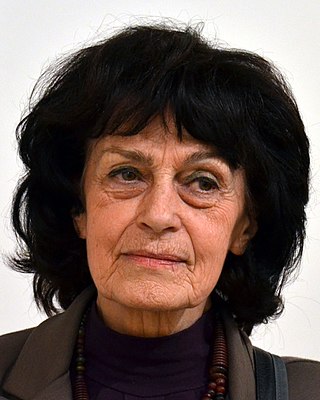
Cornelia Weihe (born 11 September 1959) is a German painter and sculptor.

Cornelia Weihe (born 11 September 1959) is a German painter and sculptor.
Cornelia Weihe was born in Karl-Marx-Stadt. [1] After her school education, she took part in practical courses, such as in a porcelain factory in Colditz, and at the Institute for Enamel Architecture in Thale. From 1981 to 1988 Weihe studied Metal Sculpture and Enamel with Irmtraud Ohme at the Burg Giebichenstein University of Art and Design in Halle an der Saale. Afterwards she worked as a freelance artist and from 1990 on as a research assistant at the Burg Giebichenstein University of Art and Design Halle. [2] In 1991 she founded the Atelier für Metallkunst together with Rainer Henze, Thomas Leu and Friedemann Knappe. [1]
In 1993, after the reunification of Germany, Weihe was one of the East and West German sculptors selected for the exhibition Stahlplastik in Deutschland (Steel sculpture in Germany) at the Staatliche Galerie Moritzburg in Halle. She took part in various sculpture symposia, including the 3rd East Frisian Sculpture Symposium of 1990 for steel sculptors in the East Frisian town of Wittmund. In 1990, she finished her work Große Liegende, which became part of the Dresden State Collection. [1]
Cornelia Weihe lives and works in Halle. She has two children.


Halle (Saale), or simply Halle (German:[ˈhalə]; from the 15th to the 17th century: Hall in Sachsen; until the beginning of the 20th century: Halle an der Saale ; from 1965 to 1995: Halle/Saale) is the largest city of the German state of Saxony-Anhalt. It is the fifth-most populous city in the area of former East Germany after (East) Berlin, Leipzig, Dresden and Chemnitz, as well as the 31st-largest city of Germany. With around 244,000 inhabitants, it is slightly more populous than the state capital, Magdeburg. With Leipzig, the largest city of Saxony, Halle forms the polycentric Leipzig-Halle conurbation. Leipzig/Halle International Airport lies between the two cities, in Schkeuditz. The Leipzig-Halle conurbation is at the heart of the larger Central German Metropolitan Region.

Isa Genzken is a German artist who lives and works in Berlin. Her primary media are sculpture and installation, using a wide variety of materials, including concrete, plaster, wood and textile. She also works with photography, video, film and collage.

Giebichenstein Castle is a castle in Giebichenstein district of Halle (Saale) in Saxony-Anhalt, Germany. It is part of the Romanesque Road.

A Kunstgewerbeschule was a type of vocational arts school that existed in German-speaking countries from the mid-19th century. The term Werkkunstschule was also used for these schools. From the 1920s and after World War II, most of them either merged into universities or closed, although some continued until the 1970s.

Otto Müller was a German painter and graphic designer.

Adéla Matasová is a Czech sculptor, multimedia artist and professor at the Art Institute.
Rita Maria Walburga Grosse-Ruyken is a contemporary German artist, sculptor, multimedia installation art, artfilm and performance, producer artist and member of the Association of German Artists Deutscher Kuenstlerbund. The core of her light – sound – space – form installations comprise sculptures in motion made from pure gold and silver. She became internationally known through her exhibition Rays of Light.
Carola Helbing-Erben is a German artist. She has worked primarily in textiles and in the creation of tapestries, and also as a mosaic artist and painter.

Moritz Götze is a German artist, publisher and art collector. His oeuvre comprises paintings, silkscreen prints, enamel paintings and mosaics, graphics and sculptures.
Brigitte Felsch-Reiff was a German painter and graphic artist. She created a comprehensive oeuvre of oil paintings and mixed media. She also produced a large number of lithographic prints and prints from wood cuts.

Jay Gard is a German artist. He lives and works in Berlin.
Hanne Bergius is a German art historian and Professor for Art History with emphases on art, photography, modern design and architecture.

Hans Wittwer was a Swiss architect who worked in Germany and who taught architecture at the Bauhaus art school in Dessau. He was a proponent of functionalist architecture; the idea that form follows function. He worked with the Bauhaus director Hannes Meyer both at the school and in a joint architectural practice in Basel. He also taught at the Kunstgewerbeschule Burg Giebichenstein in Halle.

Gerhard Lichtenfeld was a German sculptor and academic teacher, whose works were installed in public space in the Halle (Saale) and Merseburg districts, and who exhibited internationally. He was awarded the Handel Prize.

Burg Giebichenstein Kunsthochschule Halle (BURG) is the university of art and design in Halle an der Saale that was established in 1915. With a student body numbering over 1,000, BURG is one of the largest universities of art and design in Germany. It offers 20 art and design degree programmes in two faculties.

Ricarda Jacobi was a painter and a protégée of Oscar Kokoschka.
Una Helga Moehrke is a German visual artist specializing in painting, drawing, performance art and experimental text. She was a Professor for Art and Art Mediation at Burg Giebichenstein University of Art and Design in Halle from 1994 to 2018.
Rudolf Heinrich was a German stage designer.
Johann-Peter Hinz was a German artist and sculptor and local politician in Saxony-Anhalt.

Paul Thiersch was a German architect and designer.